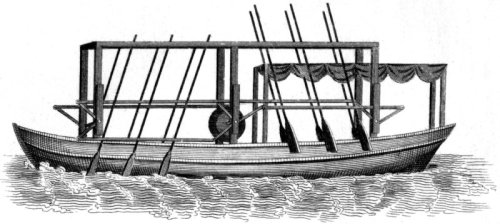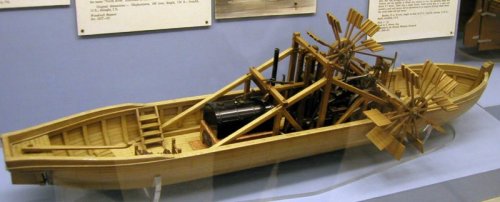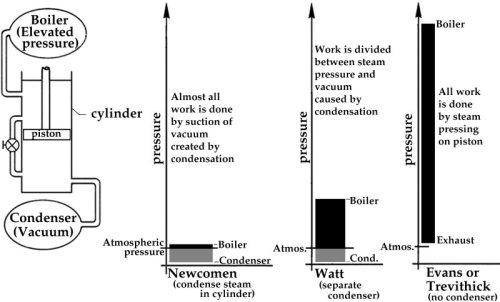Not only were Watt's new engines more efficient, their power-to-weight ratios were also greater. Putting a huge Newcomen engine in a vehicle was a bit of stretch, although people did try it. But now steam-powered vehicles were becoming highly plausible. The largest existing vehicles were ships, so they were first to use steam engines.
But people also experimented with steam cars early on. In 1771, Nicolas Cugnot developed a three-wheeled, steam-powered caisson puller for the French army. It moved 2-1/2 miles an hour for ten minutes at a time. A driver finally lost control of it and crunched it into a wall.
In 1784, a Boulton and Watt engineer worked on a series of small cars. To keep the engine small he had to use high-pressure steam; but Watt didn't trust boiler makers at such pressures. He and Boulton patented a steam vehicle, not to sell it, but to keep others from messing with anything so dangerous.
Steamboats were another matter. Even without Watt engines, people began making them. In 1783, the marquis de Jouffroy built his own version of a Newcomen-type atmospheric engine and installed it in a 140-foot boat. He ran it for fifteen minutes before cheering crowds along the Saone River. Alas, the hull started breaking up under the pounding of the engine, and his work went no further.
Then a true American original, John Fitch, entered the game. Fitch was born in Connecticut, had a hard childhood, became a silversmith, served for a while as an officer in the Colonial Army, and finally went off to the Ohio River basin (ostensibly as a surveyor) to seek his fortune. He knew that our vast inland rivers held the potential for steamboat traffic.
Fitch built an engine that combined features of both Newcomen's and Watt's engines. They moved from mistake to mistake until they had built a working steamboat. It was an odd machine, driven by racks of Indian-canoe paddles. The next year they changed the design and kept improving it. Finally, in the summer of 1790, they had a steamboat that ran fairly consistently. Now it was powered by a stern paddlewheel.

An 1832 image of Fitch's first boat (The Edinburgh Encyclopaedia)
That summer, Fitch carried passengers between Philadelphia and Trenton. His boat logged thousands of miles, traveling about seven miles an hour. In the end, the effort failed commercially, but that shouldn't distract us from the magnitude of the accomplishment.
Fitch was intense, driven -- sometimes erratic. He had constant trouble with financial backing. But he'd shown that a steamboat could move faster than a walk and could compete with a horse over long distances. That was a fundamental breakthrough.
Seventeen years later, Fulton demonstrated his famous boat on the Hudson River. He was soon carrying freight and passengers on our great rivers. But Fulton's steamboat moved no faster than Fitch's. Steam was about to give us speed -- but on land, not water. Fitch's boat was both the first and last vehicle to set a speed record that was not on land or in the air.
Once steam pressures could be pushed to fifty pounds per square inch, engines could be made much smaller. And a new generation of precision boring mills made tight-fitting pistons that could hold high pressures. So think about that word choo-choo that we used for trains when we were children.

Model showing the structure of Fulton's North River Steamboat (The Clermont) (London Science Museum, photo by author)
Choo-choo was the sound of uncondensed steam exhausting into the air. It told us that an engine no longer used a condenser, once so essential for efficiency. As we raised steam pressures, the contribution of the condenser to the power output became less. When it became feasible to quit hauling a condenser around, steam-powered vehicles made real sense.

Cornish inventor Richard Trevithick, and American millwright Oliver Evans, each began making high-pressure non-condensing engines after 1800. Both used them to power primitive cars. Trevithick's car reached nine miles-an-hour. Evans built an ambitious steam dredge that ran on both land and water. With a proper classical flair, he named it Orukter Amphibolos.
But then Trevithick turned his attention to steam locomotion on rails. Horse-drawn rail systems were used to move ore in mines, to carry industrial goods over modest distances, and to portage goods between canal ports. So rails already existed. Trevithick ran the first working locomotive in Wales in 1804. Four years later, he ran a small closed-circuit railroad in London -- a sort of carnival ride with a locomotive called the Catch-me-who-can. It moved at a swift twelve miles-an-hour. Speed, it appears, was now within our grasp, and the railways would provide it.
- A. Burton, Richard Trevithick: Giant of Steam, (London: Aurum Press, 2000).
- C. McGowan, Rail, Steam, and Speed: The Rocket and the Birth of Steam Locomotion. (New York: Columbia University Press, 2004).
- N. Faith, The World the Railways Made. (New York: Carroll & Graf Publishers, Inc., 1990): pp. 33-34.
- The early history of steam boats is told very well by two authors. The classic text is J. T. Flexner, Steamboats Come True: American Inventors in Action. (Boston: Little, Brown and Company, 1944/1978); and a more recent books provides an excellent account which focuses particularly on the pioneering work of John Fitch: A. Sutcliffe, Steam: The Untold Story of America's First Great Invention. (New York: Palgrave Macmillan, 2004).
- For the thermodynamics of steam engines, see any good undergraduate engineering text on the subject: Two excellent treatments are the classics: J. H. Keenan, Thermodynamics. (New York: John Wiley and Sons, Inc., 1941 and further editions) and W. C. Reynolds and H. C. Perkins, Engineering Thermodynamics. (New York: McGraw-Hill 1977 and further editions.)